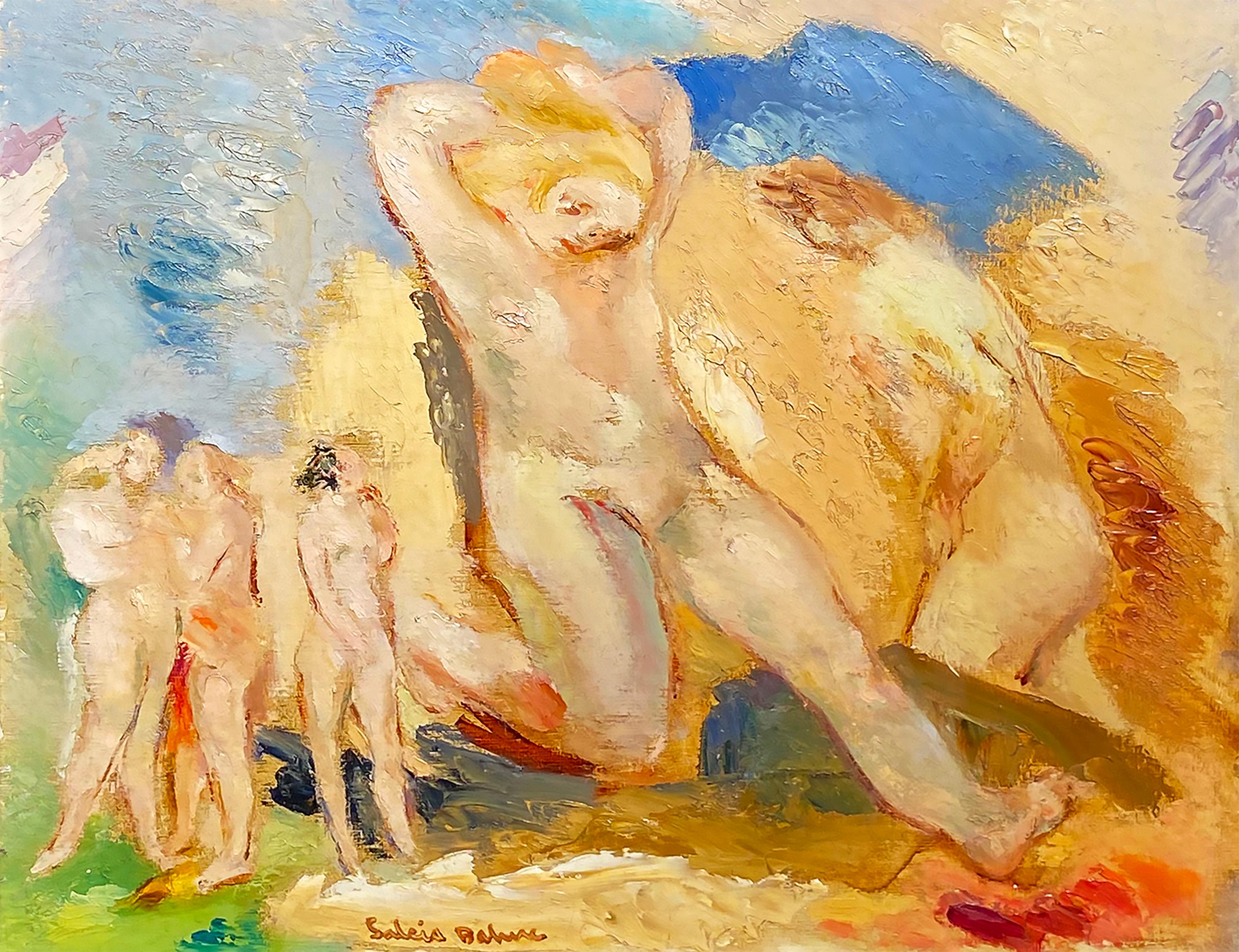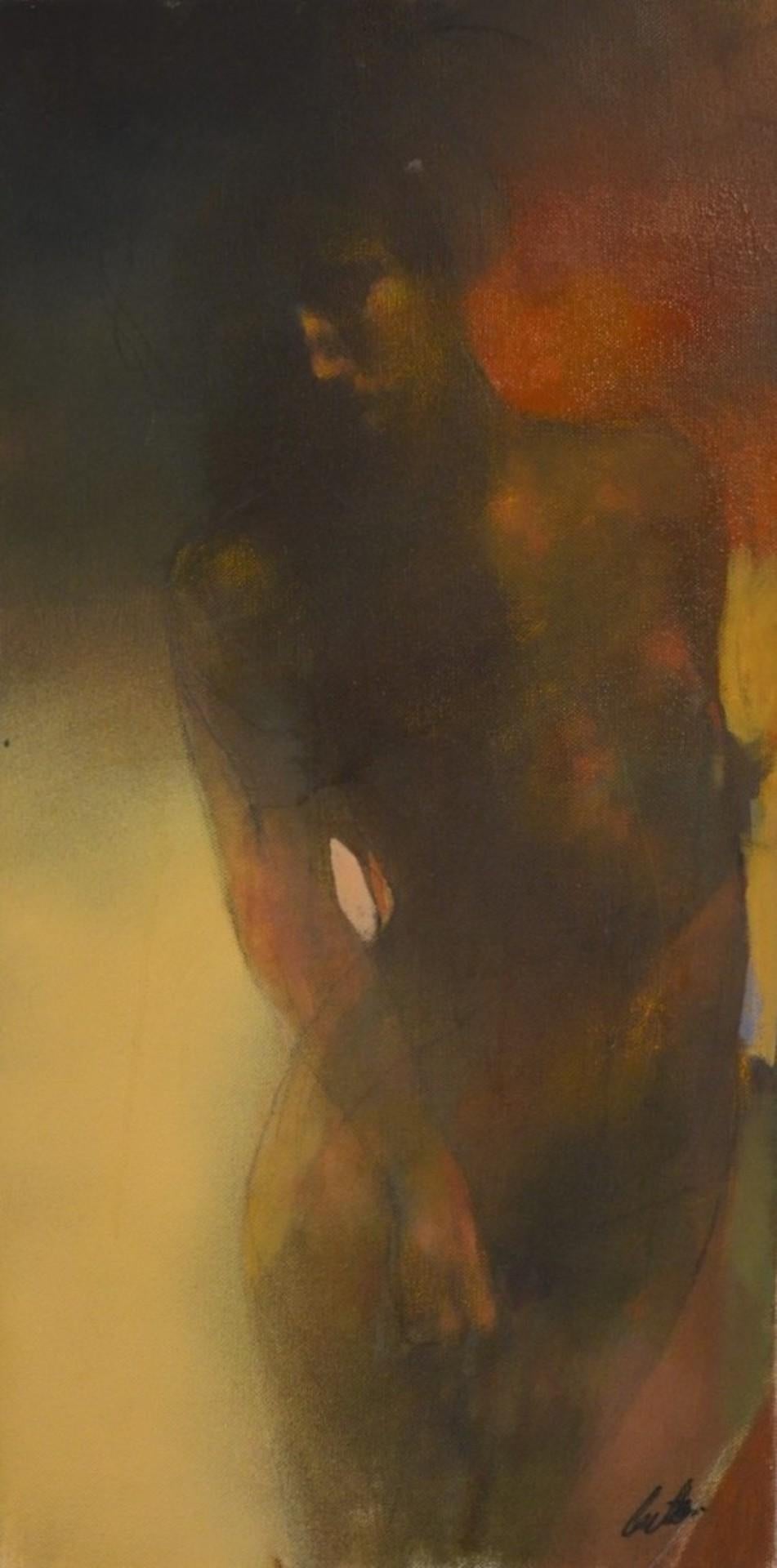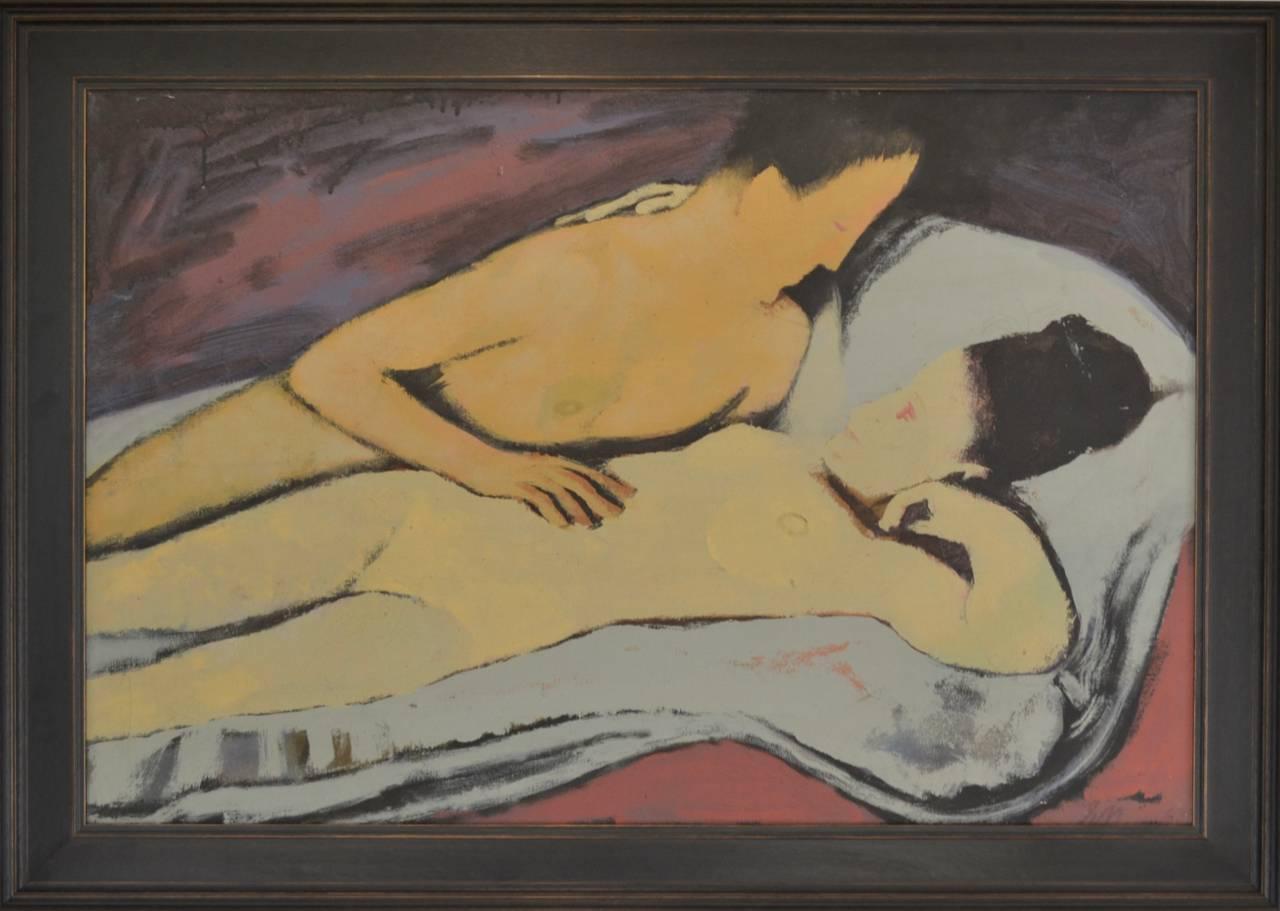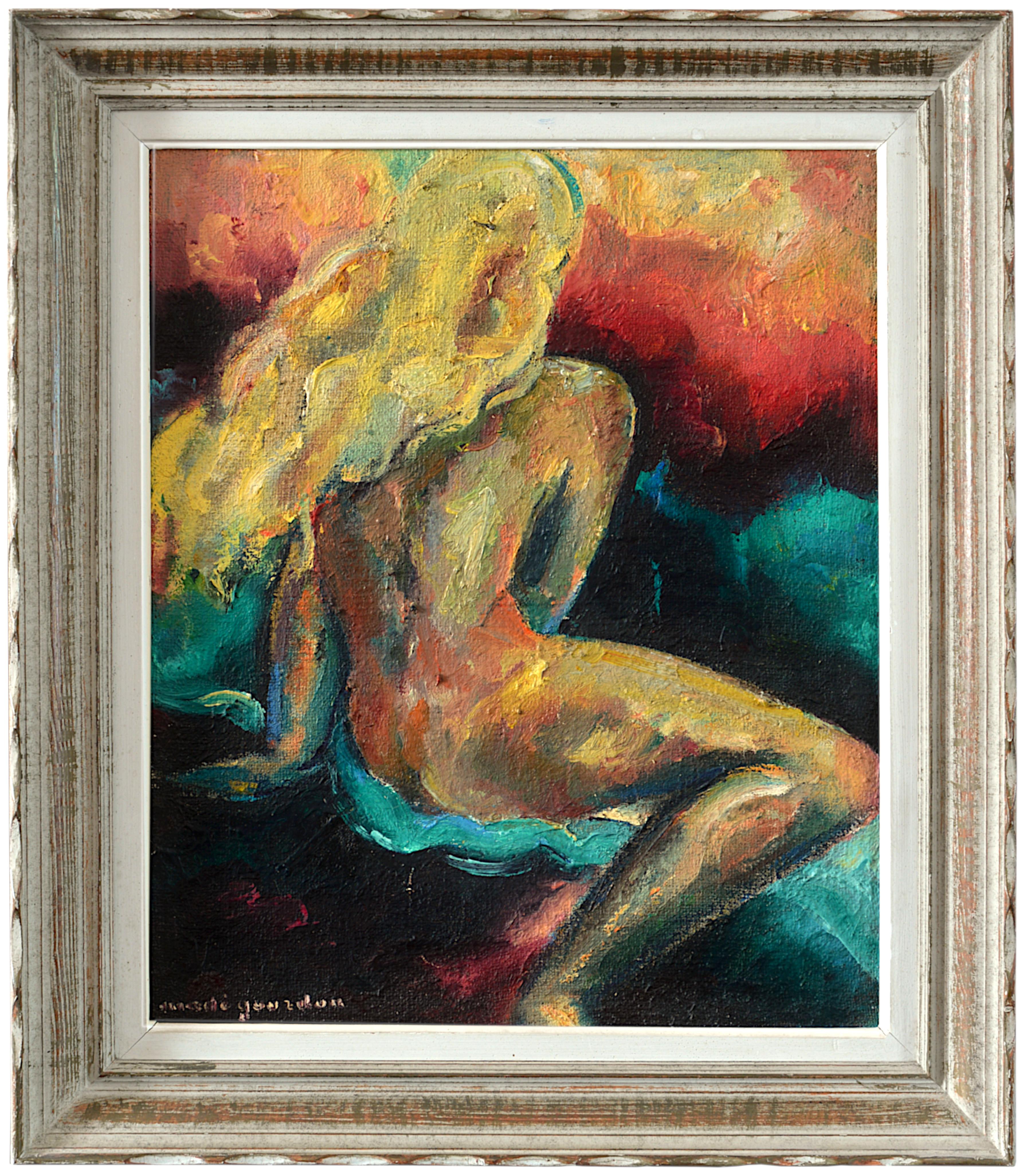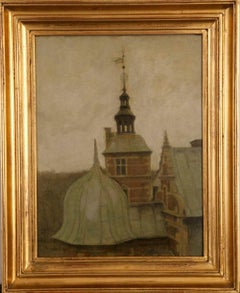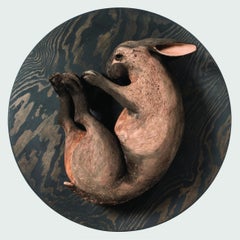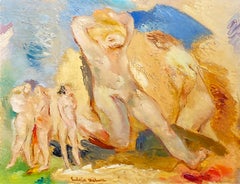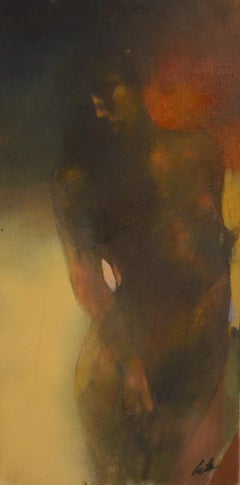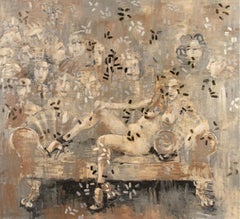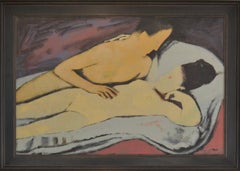Items Similar to Seated Nude
Want more images or videos?
Request additional images or videos from the seller
1 of 5
Helge HelmeSeated NudeCirca 1930
Circa 1930
About the Item
Axel Henry Helge Helme (1894 Roskilde, Denmark 1987), Seated Nude, circa 1930, oil on canvas, original frame
Son of a merchant, Helge Helme was admitted to the Academy of Arts in 1918 studying under P Rostrup Bøyesen. He appreciated female beauty often drawing and painting nudes. He received the glory of Johan Frantz Ronge in 1927.
- Creator:Helge Helme (1894 - 1987, Danish)
- Creation Year:Circa 1930
- Dimensions:Height: 22.05 in (56 cm)Width: 18.12 in (46 cm)Depth: 3.15 in (8 cm)
- Medium:
- Movement & Style:
- Period:
- Condition:
- Gallery Location:New York, NY
- Reference Number:Seller: CS10001stDibs: LU94932988611
About the Seller
5.0
Vetted Seller
These experienced sellers undergo a comprehensive evaluation by our team of in-house experts.
1stDibs seller since 2018
- ShippingRetrieving quote...Ships From: New York, NY
- Return PolicyThis item cannot be returned.
Authenticity Guarantee
In the unlikely event there’s an issue with an item’s authenticity, contact us within 1 year for a full refund. DetailsMoney-Back Guarantee
If your item is not as described, is damaged in transit, or does not arrive, contact us within 7 days for a full refund. Details24-Hour Cancellation
You have a 24-hour grace period in which to reconsider your purchase, with no questions asked.Vetted Professional Sellers
Our world-class sellers must adhere to strict standards for service and quality, maintaining the integrity of our listings.Price-Match Guarantee
If you find that a seller listed the same item for a lower price elsewhere, we’ll match it.Trusted Global Delivery
Our best-in-class carrier network provides specialized shipping options worldwide, including custom delivery.More From This Seller
View AllHerfølge Church under Walløe Ridge
By Eiler Rasmussen Eilersen
Located in New York, NY
Eiler Rasmussen Eilersen (1 March 1827, Østerby, Faaborg-Midtfyn Municipality – 24 April 1912, Copenhagen), Herfølge Church under Walløe Ridge, oil on canvas, signed: E.R. Eilersen, ...
Category
19th Century Land Landscape Paintings
Materials
Canvas, Oil
Price Upon Request
View over the Roof-tops of Frederiksborg Castle, Denmark
By Svend Hammershøi
Located in New York, NY
Svend Hammershoi (1873 Frederiksborg, Copenhagen 1948), View over the Roof-tops of Frederiksborg Castle, Denmark, Oil on Panel, Signed: SH, in it's original frame
"Designer, painter and trained ceramicist, Svend Hammershøi was the younger brother of Vilhelm Hammershøi...
Category
Early 20th Century Academic Paintings
Materials
Oil, Panel, Paint
Mirror Mirror
By Margit Brundin
Located in New York, NY
A collection of works by Swedish ceramic artist Margit Brundin, of human-scale hares created for this exhibition, A Place Behind the Oak Tree, transforms our gallery. Installed among...
Category
21st Century and Contemporary Sculptures
Materials
Ceramic
Price Upon Request
Back to Earth
By Margit Brundin
Located in New York, NY
Margit Brundin, Swedish, (b. 1981, Ängelholm, Sweden)
A collection of works by Swedish ceramic artist Margit Brundin, of human-scale hares created for this exhibition, "A Place Behi...
Category
21st Century and Contemporary Sculptures
Materials
Ceramic
Price Upon Request
Strömma ner på Rygg
By Margit Brundin
Located in New York, NY
Margit Brundin, Swedish, (b. 1981, Ängelholm, Sweden)
A collection of works by Swedish ceramic artist Margit Brundin, of human-scale hares created for this exhibition, "A Place Behi...
Category
21st Century and Contemporary Sculptures
Materials
Ceramic
Price Upon Request
Watching You
By Margit Brundin
Located in New York, NY
A collection of works by Swedish ceramic artist Margit Brundin, of human-scale hares created for this exhibition, "A Place Behind the Oak Tree", transforms our gallery. Installed amo...
Category
21st Century and Contemporary Sculptures
Materials
Ceramic
Price Upon Request
You May Also Like
Nudes
Located in Missouri, MO
Nudes
By. Salcia Bahnc (Polish, American, 1898-1976)
Signed Lower Middle
Unframed: 14 x 18 inches
Framed: 23 x 26 inches
Painter, illustrator, printmaker, teacher. Born in Dukla, Poland. Though she was born in Dukla, a town in south-eastern Poland, she moved to Prsemysl, one of the largest and most ancient cities of southern Poland, at a young age. Her mother was reportedly descended from the "Van Ast" family, a Dutch dynasty that produced several artists, including Balthasar van der Ast (1593/4 - 1657). According to one art historian she came to New York at the age of five (c. 1903), and another, at the age of eight (c. 1906).
Her family was Jewish and reportedly quite wealthy. Why they would have left imperial Austria, under whose sovereignty either of her proposed birth cities were under, is unknown. However, while these areas did not suffer the pogroms typical in neighboring imperial Russia, the Austro-Hungarian empire had become much more anti-Semetic, which may have hasten there departure. How, according to one source, they ended up living in the Jewish ghetto of New York is extremely puzzling. Did they loose their wealth to some business disaster? Where they forced to leave it behind? Was there some familial tragedy? We may never know.
In her youth she lived first in New York City and then in Boston, Massachusetts, where her family had relatives. It is reported that when she was in fourth grade she was found to be so competent in drawing that for the next two years she taught a drawing class after school for the other children. In Boston, Bahnc's mother eventually remarried and moved the family to Chicago where the young artist was primarily raised.
In Chicago she worked during the days as a sales clerk in a department store. At night she put herself through school at the School of the Art Institute of Chicago (SAIC) and taught at her former alma mater after her graduation during the years 1923-1929. She also studied at the Chicago Academy of Fine Art. She took up design work and began exhibiting painted silk creations at a private Chicago gallery (probably Thurber, see below). The first museum exhibitions she is known to have participated in were held at the Art Institute of Chicago. During this period she became known for her portraits.
Originally a resident alien, she was naturalized at the district court of Chicago, Illinois in July of 1913. In 1920 she lived on East Ontario Street in Chicago in a neighborhood filled with art studios and artists, including James Allen Saint-John (1872-1957), Paul Bartlett (1881-1965), Pauline Palmer (1867-1938), and George Ames Aldrich (1872-1941). It is in Chicago that she saw her greatest success as an artist. In 1927, Chicago art dealer Chester H. Johnson said of her work: "The Art of Salcia Bahnc is a sincere manifestation of the spirit we know as 'Modernism' . . . . . . She is the spirit of the Age, not its Fashion." Local reviewers agreed, one going as far to say that her exhibition was " . . . the most interesting one man show by a young artist that has ever been presented to Chicago, and I keep telling myself that New York will get her if we don't watch out."
She was apparently a favorite and friend of art critic Clarence Joseph Bulliet (1883-1952), who authored a number of books and articles that praised Bahnc's work. Bulliet was central in introducing and popularizing modern art in the mid-western United States. In his book Apples and Madonnas: Emotional Expression in Modern Art (1935) he called Bahnc a "A thorough Expressionist." A year later in his book The Significant Moderns and Their Pictures (1936) he noted that one of her paintings of a nude was ". . . powerful in its elemental brutality."
During this period other critics reported positively on the work she was producing. Ida Ethelwyn Wing reported in a volume of the Delphian Text (1930) that Bahnc, was without doubt, ". . . the most vigorous and intensively original of the American Expressionists." Paul Masserman and Maxwell Baker said of her in their work The Jews come to America (1932) that she was part of a group of artists that were "Chief among modern Jewish painters. . . "
Salcia Bahnc traveled back and forth to Europe during the late 1920s and into the 1930s, a period when she faced the rise of totalitarianism. She wrote about this fact to a fellow artist to whom she commented " . . . about the difficult art scene in Paris . . . . . . and the growing power of fascism." In 1930 she was maintaining a studio in New York City at 1218 East 53rd Street and a residence in Brooklyn, Long Island. She returned to France where she married a French citizen and writer named Eugene Petit (b. 1901) and bore a son there named Alain Petit (b. 1934). She again returned to the United States in November of 1937 and traveled back to France after a brief stay in America. During her stay she continued to exhibit in Chicago, where Quest Galleries gave her a solo show.
Like so many ex-patriot authors and artists who were living in Paris, she found herself trapped in France (first in Paris, then in Mayenne) following the German invasion in 1940. Being of Jewish extraction the situation could prove to be quite dangerous if she were reported or discovered by German authorities. She and her husband were able to obtain passports and escape to Portugal where in August of 1941 they boarded the S. S. Escambion to return to America.
In 1940, American Export Lines, owners of the Escambion, discontinued its normal Mediterranean routes and placed their ships into service sailing from Lisbon, Portugal to New York City. Over the next two years (1940 - 1941) their ships played an important role in transporting thousands of people who were trying to escape the Nazi regime before America's own entry into World War II. One survivor, Ludwig Lowenberg, who sailed on the Escambion on the same day that Bahnc did, reported the ordeal his family endured getting to Lisbon to his own descendants:
"[The family] received their American visa on May 28, 1941, only three days before the U.S. consulate in Stuttgart closed for the duration of World War II. They left Berlin on June 23, 1941, traveling for 27 hours on a locked train to Paris. There they were forced to spend an additional night in the locked train until their coach was attached to a train headed for San Sebastian in Spain. After an overnight hotel stay in San Sebastian, the train (now no longer locked) continued to Lisbon. All in all it took six days from Berlin to Lisbon. They remained for four weeks in Lisbon until they embarked on the Excambion for New York."
Bahnc had given up her citizenship during her time in France and was forced to reapply for naturalization once again upon her return. She was living in New York City at 101 West 85th Street when she was re-naturalized in April of 1947.
Exactly how much of her artwork was lost in Europe is not known. Clearly, she would not have been able to bring much, if anything, with her during her escape. One writer had noted that between 1930 and 1934 she had worked hard to prepare a large group of new works for a show in Paris. Between those, and what she would have produced during the next six years, the actual amount of the loss might have been staggering. Bahnc's 1942 exhibition with Julio de Diego included works recalling the suffering going on in Europe. One work in the exhibition was a portrait of the painter Katherine Dudley, who, at the time, was reportedly interned near Paris.
In the later years of her career she worked extensively as a teacher and illustrator of children's books. In 1950 she taught at the Evanston Art Center, where she lead a demonstration in portrait painting. She authored or illustrated a number of works during and after World War II, including: The House in the Tree and Other Stories of Places, People and Things (1941); Claude Of France: The Story Of Debussy For Young People (1948); Time for Poetry (1951); Hidden Silver (1952); From Many Lands - The Children's Hour, Volume 9 (1969); and That Boy (no date). She returned to teach at the School of the Art Institute of Chicago during 1943-44 and 1947-53; and taught later at the Garrison Forest School in Garrison, Maryland, from 1955-57.
Bahnc was known to have exhibited widely, both in Europe and in America. Her known lifetime exhibitions include: The Art Institute of Chicago, Chicago, IL, 1919-29, 1942 (The 53rd Annual; and Room of Chicago Art: Exhibition of Paintings by Salcia Bahnc and Julio de Diego), 1943; Chicago Architectural...
Category
20th Century Expressionist Nude Paintings
Materials
Oil, Canvas
Price Upon Request
Emerging, Bill Bate, Original Figurative Painting, Nude Portraiture, Affordable
By Bill Bate
Located in Deddington, GB
Bill Bate
Emerging
Original Figurative Painting
Oil Paint on Canvas
Canvas Size: H 60cm x W 30cm x D 2cm
Sold Unframed
Please note that in situ images are purely an indication of how...
Category
21st Century and Contemporary Expressionist Nude Paintings
Materials
Oil, Canvas
Paul Manes - Suzanna...Later, Paintings 2020
By Paul Manes
Located in Greenwich, CT
Paul Manes was born May 4, 1948, in Austin, Texas. He began his professional career in New York City in the early 1980s. His art has been widely exhibited in America and Europe and h...
Category
2010s Expressionist Nude Paintings
Materials
Canvas, Paint, Oil
Price Upon Request
"Erste Beruhrung" First Stirrings
By Ernst Neuschul
Located in Brecon, Powys
Oil on canvas, signed and dated 'EN [19]63' lower right, titled and dated to stretcher, numbered 33 and with paper label 34 to stretcher,
From the family of the artist by direct des...
Category
1960s Expressionist Figurative Paintings
Materials
Oil, Canvas
$5,525 Sale Price
35% Off
Dream
Located in Saint Amans des cots, FR
Oil on canvas by Madé Gourdon, France, 1960s. "Dream". with frame: 70x61 cm - without frame: 55x46 cm. 10F format. Signed "Madé Gourdon" in the lower left. In its frame Montparnasse....
Category
1960s Expressionist Figurative Paintings
Materials
Burlap, Oil, Canvas
$1,200
Two ladies with glasses
Located in Wien, 9
Gurami Hagemann was born in Tiblissi in Georgia in 1945. At the age of 15 he received his diploma in painting. From 1965 to 1971 he attended the Art Academy in Tiblissi. In 1993 he r...
Category
20th Century Expressionist Nude Paintings
Materials
Canvas, Oil
Recently Viewed
View AllMore Ways To Browse
Original Nude
Vintage Female Nude Art
Nude Females Original
Vintage Beauty Nude
Zsa Zsa Gabor
Vintage Lady Justice
Equal Justice
Bill Jones American Painter
Hawaii Nude
Hawaiian Nude
Jack Justice
Orientalist Nude
Male Nude Old Masters
Cubist Nude Women
Jack Justice Painting
Naked Lady Painting
Modernist Male Nudes
Florence Knoll Model 31
